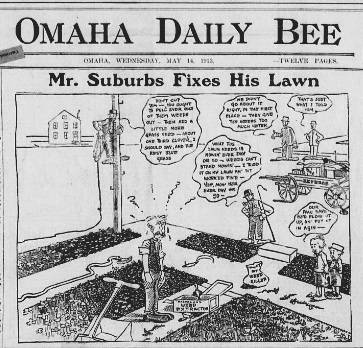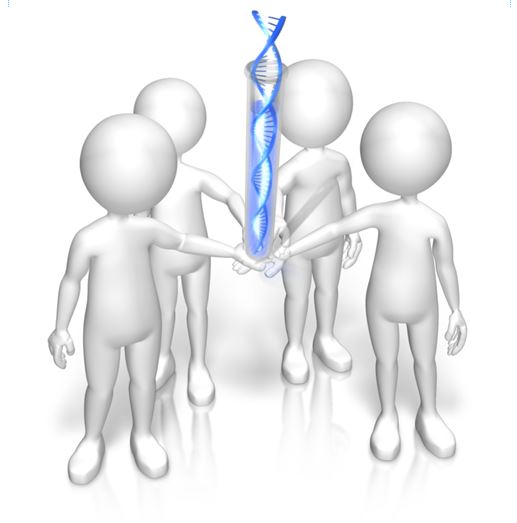by Lisa Cooke | May 14, 2013 | 01 What's New, Newspaper
Spring is in the air, as it was 100 years ago today. On May 14, 1913 the Omaha Daily Bee, the front page sported a comic depicting the eternal struggle of suburban life – fighting weeds in an effort to achieve the perfect lawn.

(Omaha daily bee., May 14, 1913, Weekly Market Review Edition, Image 1 Omaha daily bee. (Omaha [Neb.]) 187?-1922)
You can view the digitized paper featuring “Mr. Suburbs” at the Chronicling America website, along with digitized papers ranging from 1836 – 1922.
To learn more about using newspapers to climb your family tree grab a copy of my book How to Find Your Family History in Newspapers.
by Lisa Cooke | May 23, 2013 | 01 What's New, Military
Here’s the latest from the National Archives:
National Archives Marks 150th Anniversary of U.S. Colored Troops

Sic semper tyrannis – 22th Regt. U.S. Colored Troops, 1864. Bowser, David Bustill, 1820-1900 , artist
Washington, DC. . . Marking (the) 150th anniversary of its creation, the National Archives announces the completion of the United States Colored Troops (USCT) Service Records Digitization Project, in partnership with Fold3. For the first time, this collection – nearly four million images of historic documents with detailed information on former slaves – is available online to anyone, anywhere.
On May 22, 1863, the War Department issued General Orders 143, establishing a Bureau of Colored Troops in the Adjutant General’s Office to recruit and organize African American soldiers to fight for the Union Army. These service records – including those of the men of the famed 54th Massachusetts Infantry featured in the movie Glory – are a treasure trove for genealogists and a rich source of documentation on the black experience in America during the Civil War.
Researchers may be surprised to find that the USCT military service records hold not only muster rolls but also a huge array of personal papers that can include enlistment papers, correspondence, orders, prisoner-of-war memorandums, casualty reports, and final statements. Starting in October 1863, slave owners could enlist their slaves and receive up to $300 upon filing a “manumission” or deed of ownership. Unique to some of the records of the USCT are these deeds of manumission and bills of sale. For genealogists, these records may offer the only source of documentation of an enslaved ancestor in the absence of other vital records.
For the first time, these valuable historical records are available online, thanks to Fold3, and to National Archives staff and volunteers who spent years preparing, preserving, microfilming, and digitizing them. The collection is available free of charge to non-subscribers on www.fold3.com/category_268 today through May 31, and can be accessed for free at any time on computers at National Archives research facilities nationwide.
In total, the USCT consisted of seven cavalry regiments; 13 artillery regiments plus one independent battery; 144 infantry units; two Brigade Bands; and other miscellaneous smaller units. Records are arranged by regiment and then alphabetically by surname of the soldier.
The USCT fought in 39 major engagements and more than 400 other ones. Sixteen African American soldiers received the Medal of Honor. The last USCT regiment was mustered out of Federal service in December 1867.
One soldier chronicled in the records is Edmund Delaney, a slave who served in Company E of the 117th USCT Infantry. Delaney was 25 years old when he enlisted in August 1864. His owner, Harvey C. Graves of Georgetown, Kentucky, filed a compensation claim for Delaney’s military service in December 1866, stating that Delaney was “purchased at private sale when he was quite a small boy.” Graves attached to his “proof of ownership” a rare photo of Delaney, and letters Delaney had written to him while serving in Brownsville, Texas.
Another soldier’s file reads like an ultimate page turner and details the tragic story of Fortune Wright, a free black man before the Civil War who served in the 96th USCT Infantry. Read USCT project manager Jackie Budell’s fascinating Prologue “Pieces of History” blog post.
More information:
by Lisa Cooke | Jan 19, 2015 | 01 What's New, DNA, Social Media
Family history organizations and studies based on individual surnames have been around for years. They are now integrating YDNA research into their efforts. Use surname projects to enhance your paternal DNA research!
Surnames are the flagships of our genealogical research. We name our files after them and we tag our research with them. We wear our last names proudly on pins and necklaces and T-shirts.
But surnames can also be misleading. Illiteracy, language barriers, and just plain carelessness led to misspellings and alterations, not to mention those ancestors who blatantly changed their name to avoid detection.
The advent of YDNA testing has changed the way many genealogists view surnames and their role in their genealogy. Because a man’s YDNA is the same as the YDNA carried by each of the ancestors in his direct paternal line, the YDNA can act like a filter, clearly indicating which men with a particular surname, or variant, truly share a direct paternal line.
So how has YDNA testing affected family organizations that do surname research? I asked Debbie Kennett, a regular contributor to the International Society of Genetic Genealogy Wiki and Facebook page who is also involved with the Guild of One Name Studies. The Guild of One Name Studies was established in 1979 to promote public understanding of one-name studies and preserve the information obtained by those studies.
“Virtually every common surname is now the subject of a DNA project,” says Debbie, including “just over 500 Guild members who are running a DNA project. That number has jumped up considerably just in the last couple of years.”
The quality of those projects varies. Debbie tells us that a quality YDNA project includes three elements: “presenting the DNA data, recruiting people from different countries and also correlating all of the genealogy information.”
Jean Morrison, a member of the Morrison surname project, says that because of DNA testing, “identifying where in Scotland this family originated prior to coming to America ca 1728 has become a realistic goal. The Morrison Q Group has identified through Y line testing at 111 markers, 22 individuals with an MRCA (most recent common ancestor) within eight generations.” In plain English, this means that a definite YDNA pattern has been associated with her Morrison surname and with a common ancestor eight generations back.
Noel and Ron Taylor were two early adopters of YDNA testing for their Taylor family project. Their first samples were submitted to the Sorenson Molecular Genealogy Foundation in 2000. The former president and currently the head of the board of trustees for the Taylor Family Society, Noel says that using DNA “caught the attention of many people in our organization….It renewed great interest in the hearts of many people who had been doing research for many years [who may have] lost interest and were somewhat discouraged.” The Taylors have made significant breakthroughs with their DNA testing. They have connected several Taylor lines back to a common ancestor, verified their paper trails, and even found a line of Hodges that were actually Taylors!
It appears that YDNA is becoming part of the research plan for most family societies. But Debbie tells us that there is still much room for improvement in her organization. “Not all Guild members are running [DNA] projects. We have something like 2,700 Guild members so we are still not at the stage where the majority of Guild members are running projects.”
Besides The Guild, other organizations have been created to assist genealogists with their surname research, including a new organization just launched in November. The Surname Society’s goal is to “to build a collaborative environment where members are encouraged to develop their own approach to the investigation of their surname.”
Kirsty Grey, chairman of the Surname Society, says that DNA testing has taken a front seat role in the research of one of their founders as well as several early members. “DNA is one of the many strands of family history research (and to a greater extent, surname studies) which can connect individuals, often where genealogical research cannot.”
That really is the bottom line. DNA, especially YDNA, can tell you things about the surnames in your pedigree that you can’t learn in any other way. If you haven’t yet, it’s time to jump on the YDNA bandwagon and see what your DNA has to tell you.
 I can help you! Check out my series of quick guides (purchase all 4 laminated guides or the digital download bundle for the best deal):
I can help you! Check out my series of quick guides (purchase all 4 laminated guides or the digital download bundle for the best deal):




